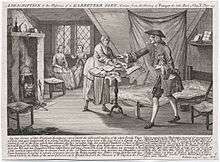Novel of circulation

The novel of circulation, otherwise known as the it-narrative, or object narrative,[1] is a genre of novel common at one time in British literature, and follows the fortunes of an object, for example a coin, that is passed around between different owners. Sometimes, instead, it involves a pet or other domestic animal, as for example in Francis Coventry's The History of Pompey the Little (1751).[2] This and other such works blended satire with the interest for contemporary readers of a roman à clef.[3]
Examples
- 1709 Charles Gildon, The Golden Spy. This work is identified as an early example. Later, an episodic structure in which objects "spied" on people became established.[4] Other generic terms used are "object tales" or "spy novels".[5]
- 1734 Anonymous, The Secret History of an Old Shoe[6]
- 1742 Claude Crébillon, The Sopha, a Moral Tale[7]
- 1753 Susan Smythies, The Stage-coach: containing the character of Mr. Manly, and the history of his fellow-travellers[7]
- 1754 Anonymous, History and Adventures of a Lady's Slippers and Shoes[8]
- 1760 Edward Phillips, The Adventures of a Black Coat[9]
- 1760–5 Charles Johnstone, Chrysal; or, The Adventures of a Golden Guinea[2]
- 1767 Charles Perronet, Dialogue between the Pulpit and Reading-Desk[7]
- 1769 Tobias Smollett, The History and Adventures of an Atom[7]
- 1771 Thomas Bridges, The Adventures of a Bank-Note[10]
- 1783 Theophilus Johnson, Phantoms: or, The Adventures of a Gold-Headed Cane[11]
- 1790 Helenus Scott, The Adventures of a Rupee[12]
- 1799 Edward Augustus Kendall, The Crested Wren[7]
- 1813 Mary Pilkington, The Sorrows of Caesar, or, The Adventures of a Foundling Dog[7]
- 1816 Mary Mister, The Adventures of a Doll[7]
- 1880 Nellie Hellis, The Story He was told; or, The Adventures of a Teacup[13]
- 1897, John William Fortescue, The Story of a Red Deer[14]
Relationship to other genres
With works of Mary Ann Kilner of the 1780s, Adventures of a Pincushion and Memoirs of a Peg-Top, it-novels became part of children's literature.[15] One offshoot was a style of satirical children's verse made popular by Catherine Ann Dorset, based on a poem by William Roscoe, The Butterfly's Ball and The Grasshopper's Feast.[16] Quite generally, it-narrative in the 19th century is typefied by an animal narrator.[17]
It has been remarked that the slave narrative genre of the 18th century avoided being confused with the it-narrative, being thought of as a type of biography.[18]
The plot of Middlemarch has been seen to be structured, initially, by a circulation; but to end in a contrasting "subject narrative".[19]
Notes
- ↑ Wolfram Schmidgen (2002). Eighteenth-Century Fiction and the Law of Property. Cambridge University Press. p. 127. ISBN 978-1-139-43482-9.
- 1 2 John Mullan (12 October 2006). How Novels Work. Oxford University Press. p. 149. ISBN 978-0-19-162292-2.
- ↑ Liz Bellamy (26 September 2005). Commerce, Morality and the Eighteenth-Century Novel. Cambridge University Press. p. 121. ISBN 978-0-521-02037-4.
- ↑ Olivia Murphy (22 February 2013). Jane Austen the Reader: The Artist as Critic. Palgrave Macmillan. p. 79. ISBN 978-1-137-29241-4.
- ↑ Mark Blackwell (2007). The Secret Life of Things: Animals, Objects, and It-narratives in Eighteenth-century England. Bucknell University Press. p. 10. ISBN 978-0-8387-5666-9.
- ↑ Jolene Zigarovich (2 May 2013). Sex and Death in Eighteenth-Century Literature. Routledge. p. 58. ISBN 978-1-136-18237-2.
- 1 2 3 4 5 6 7 Mark Blackwell (2007). The Secret Life of Things: Animals, Objects, and It-narratives in Eighteenth-century England. Bucknell University Press. pp. 135–8. ISBN 978-0-8387-5666-9.
- ↑ Wolfram Schmidgen (2002). Eighteenth-Century Fiction and the Law of Property. Cambridge University Press. p. 128. ISBN 978-1-139-43482-9.
- ↑ Christina Lupton (29 November 2011). Knowing Books: The Consciousness of Mediation in Eighteenth-Century Britain. University of Pennsylvania Press. pp. 49–. ISBN 0-8122-0521-9.
- ↑ Nicholas Hudson (2005) "Social Rank, "The Rise of the Novel," and Whig Histories of Eighteenth-Century Fiction, Eighteenth-Century Fiction: Vol. 17: Iss. 4 (2005), at p. 587]
- ↑ David Scott Kastan (2006). The Oxford Encyclopedia of British Literature. Oxford University Press. p. 114. ISBN 978-0-19-516921-8.
- ↑ Liz Bellamy (26 September 2005). Commerce, Morality and the Eighteenth-Century Novel. Cambridge University Press. p. 120. ISBN 978-0-521-02037-4.
- ↑ Mark Blackwell (2007). The Secret Life of Things: Animals, Objects, and It-narratives in Eighteenth-century England. Bucknell University Press. p. 142. ISBN 978-0-8387-5666-9.
- ↑ Mark Blackwell (2007). The Secret Life of Things: Animals, Objects, and It-narratives in Eighteenth-century England. Bucknell University Press. p. 144. ISBN 978-0-8387-5666-9.
- ↑ Mark Blackwell (2007). The Secret Life of Things: Animals, Objects, and It-narratives in Eighteenth-century England. Bucknell University Press. p. 280. ISBN 978-0-8387-5666-9.
- ↑ Frederick Burwick; Nancy Moore Goslee; Diane Long Hoeveler (30 January 2012). The Encyclopedia of Romantic Literature. John Wiley & Sons. p. 237. ISBN 978-1-4051-8810-4.
- ↑ Laura Brown (2010). Homeless Dogs & Melancholy Apes: Humans and Other Animals in the Modern Literary Imagination. Cornell University Press. p. 123. ISBN 0-8014-4828-X.
- ↑ John Ernest (2014). The Oxford Handbook of the African American Slave Narrative. Oxford University Press. p. 70. ISBN 978-0-19-973148-0.
- ↑ Leah Price (9 April 2012). How to Do Things with Books in Victorian Britain. Princeton University Press. p. 108. ISBN 1-4008-4218-2.